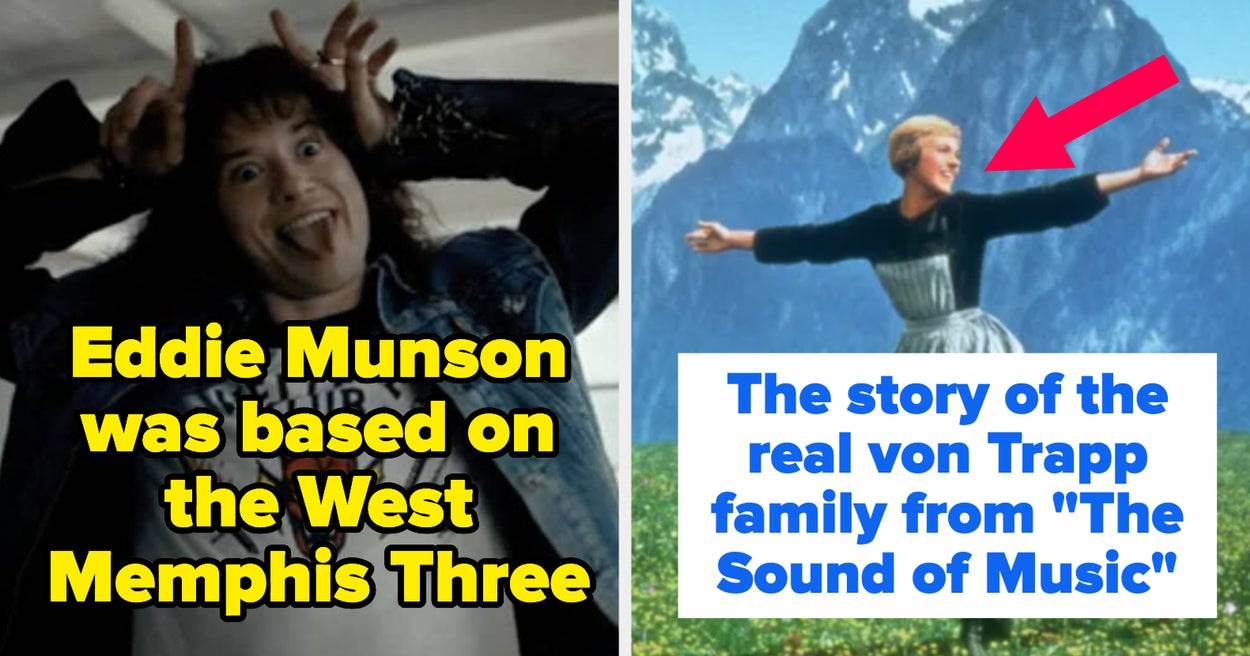Have you ever gone down a major internet rabbit hole after watching a movie or a TV show that’s based on real events? TBH, it might just be one of my favorite pastimes.
I rounded up some of the most interesting real-life events that were turned into on-screen moments, from the horrific crime spree that inspired Scream to the group of teens that Stranger Things‘ Eddie Munson was based on.
1.
Stranger Things‘s Eddie Munson, played by Joseph Quinn, became one of the breakout characters of the show’s most recent season. His storyline, which involves him being accused of a murder he didn’t commit because of his love for playing Dungeons & Dragons with the Hellfire Club, was inspired by Damien Echols, who was similarly accused of murder in 1994 as part of the West Memphis Three.
On May 5, 1993, three eight-year-old boys went missing while riding their bikes in West Memphis, Arkansas. The next day, police found their bodies bound and mutilated in a drainage ditch. Authorities believed the murders were tied to devil worship, and immediately turned their attention to Damien Echols, an 18-year-old high school dropout and self-proclaimed Wiccan. A local woman claimed she had evidence that helped police link Echols, his best friend Jason Baldwin, and Jessie Misskelley Jr. to the murders. Misskelley told police that he helped Echols and Baldwin detain the young boys, then left before they were murdered.
In June 1993, all three were arrested, despite the fact that they had alibis, and there was no physical evidence that linked them to the murders. Miskelley went on trial separately. There were several inconsistencies in his testimony, but he was sentenced to first- and second-degree murder and sentenced to life without parole. Miskelley refused to testify at Echols and Baldwin’s trial, so the police had to rely on circumstantial evidence, including Echols’ interest in Metallica and Stephen King’s novels. Both Echols and Baldwin were found guilty of first-degree murder, and Echols was given the death penalty. In 1996, the documentary Paradise Lost aired on HBO. The documentary raised serious doubts about the involvement of the West Memphis Three, and the men soon began receiving support from the public. Two more installments of the documentary were released. In 2011, their convictions were vacated and they were released from prison.
So, what drew the Duffer Brothers to this case while writing Eddie’s character arc? “We really wanted that character who’s a metalhead, he’s into Dungeons & Dragons, he’s ultimately a true nerd at heart,” Ross said. “But from an outsider’s point of view, they may go, ‘This is someone that is scary.’ So that’s really where the idea for Eddie came in.” Elements of Echols’ story, including his interests, are especially visible in the character. “What’s sad about [Eddie’s] narrative is that the people who get to know him love him, and the people who don’t have judged him horribly, just because of the way he dresses and just because of his interests.”
2.
In September 1961, Betty and Barney Hill, a married couple, were driving back to their home in New Hampshire from a camping trip in Canada when they claimed they had been abducted by aliens. The Hills reported seeing lights in the sky before allegedly witnessing a spacecraft full of “bipedal humanoid creatures” land in a nearby field. Following the landing, the Hills said they had no recollection of the next few hours. When the couple returned home, they said they noticed several alarming changes: Betty’s dress was allegedly stained and torn, Barney’s shoes were scraped, and the leather strap of their binoculars was destroyed.
In the years after the alleged abduction, the Hills were still experiencing lingering effects, and they sought hypnosis therapy to help them recall exactly what happened to them. After about a year of therapy, both began to piece together stories about what they experienced. They also drew a diagram of the spacecraft that became one of the first examples of the flying saucer UFO. By 1965, their story had been published in a Boston newspaper. Soon after, the story was expanded into a book called The Interrupted Journey and was later adapted into The UFO Incident, a movie starring James Earl Jones.
While the Hills’ story was not the first time civilians had claimed to come into contact with aliens, it was one of the first times that the experience had been portrayed as anything but friendly. Some believed that the Hills had made the entire thing up. The Air Force ultimately dismissed the Hills’ story. The Hills’ story has since appeared in pop culture, most notably in American Horror Story: Asylum.
3.
During Hurricane Katrina in New Orleans, over 2,000 doctors, nurses, patients, and other hospital personnel were sheltered inside Memorial Hospital. As Katrina doused the city, windows shattered and the building shook as the occupants huddled for cover. At some point early the next morning, the power in the hospital went out, rendering some patients, who relied on electronic medical devices to survive, in grave danger. Although the hospital was equipped with generators, they were only designated for emergency lights and equipment that was deemed necessary for survival.
Once the storm passed, Memorial’s occupants, largely unaware of the true impact of the storm, awaited rescue. By the morning of August 30, the levees holding back the stormwater snapped, sending water from nearby Lake Pontchartrain flooding through the city. The power grid at Memorial Hospital was located only a few feet above ground, leaving it at risk of severe electrical damage. There was no choice but to evacuate the hospital, including over 200 vulnerable patients. The hospital’s emergency plan did not cover what to do in case of a flood, so executives quickly formulated new guidelines: critical patients and babies in the NICU would be rescued first, while anyone with a Do Not Resuscitate order would be the last to leave because they “had the least to lose.”
The issue? Memorial Hospital was home to LifeCare, an independent hospital for patients that needed close care around the clock. Most of LifeCare’s 52 patients were on ventilators and were largely left out of the rescue conversations being held by hospital executives. As patients from the main hospital began the evacuation process, LifeCare employees realized they weren’t included in the evacuation and were told that if they wanted to be rescued, they needed to seek permission from hospital executives. Dr. Ewing Cook, who worked for Memorial, ordered that all treatments, except those deemed essential, be stopped to lessen the burden on nurses. On August 31, the generators failed, with all 52 LifeCare patients still inside the hospital.
By September 1, employees at Memorial and LifeCare brought all remaining patients to the hospital’s first floor and categorized them by likelihood of survival in order to determine who to evacuate first, with Dr. Anna Pou leading the charge. After seeing how slowly the evacuation was progressing, Pou and a team of nurses allegedly gave LifeCare patients a dose of morphine and Versed, a fast-acting sedative, a combination that was known to induce death. When the hospital was investigated in the weeks following Katrina, 45 bodies were recovered. After performing toxicology reports on the bodies, investigators discovered that 23 of them tested positive for the deadly combination, and all had died in the same three-hour span. Doctors later told authorities that they overheard Pou and Cook discussing euthanasia.
It was later determined that at least nine of the deaths could be deemed homicides. On July 17, 2006, Pou was arrested and charged with four counts of second-degree murder, while Lori Budo and Cheri Landry, nurses who assisted Pou, were arrested. Budo and Landry had their charges dropped in exchange for their testimony. In 2007, a grand jury decided not to indict any of the suspects for their actions at Memorial Hospital. Pou is still a practicing doctor in Louisiana. Sheri Fink chronicled the story in her book Five Days at Memorial. An adaptation of the book, also called Five Days at Memorial, premiered on Apple TV+.
View this video on YouTube
Apple TV+ / Via youtube.com
4.
Did you know that the von Trapps from The Sound of Music were based on a real family? While the film portrayed Maria, played by Julie Andrews, as arriving to serve as governess for all of the children, she actually came to the von Trapp family to tutor one of the children, Maria Franziska, who had come down with scarlet fever. When Maria arrived, she quickly fell in love with all of the children but did not initially love Georg, their father. Despite this, the pair married in 1927. “I really and truly was not in love. I liked him but didn’t love him. However, I loved the children, so in a way, I really married the children,” she wrote in her memoir. “[B]y and by, I learned to love him more than I have ever loved before or after.”
Both Georg and Maria underwent some personality shifts in the movie. At the beginning of the film, Georg is portrayed as gruff and harsh. In reality, his family said, he was actually a loving father who loved engaging in musical activities with his children. This change allegedly hurt his family, who felt uncomfortable with their father being shown as detached. Meanwhile, Maria actually appeared sweeter and more loving in the movie than she was in real life. While she was very caring toward the children, they noted that she had a temper that was not revealed in the film. She “had a terrible temper,” Maria Franziska, her stepdaughter, revealed. “And from one moment to the next, you didn’t know what hit her. We were not used to this. But we took it like a thunderstorm that would pass, because the next minute, she could be very nice.”
Other elements of the von Trapp family’s story that were changed for the movie included the names, ages, and genders of the children. While the movie shows seven von Trapp children, there were actually 10 of them. In addition, the family loved to perform music before Maria arrived, although she did teach them how to sing madrigals, as seen in the movie. In the movie, the family is shown making their way to freedom over the Swiss border on foot. In reality, the family actually fled to Italy, where Georg was a citizen because he had been born in Zadar, which became part of Italy in 1920. Maria and the children were also granted citizenship through this loophole and were able to reach Italy, then progressed to America.
So, what happened to the von Trapp family after the events of the movie? In the 1940s, they toured America as the Trapp Family Singers. After their tour, they settled down in Stowe, Vermont, where they opened the Trapp Family Lodge, a guesthouse. The lodge is still owned and operated by descendants of the von Trapp children.
5.
Patch Adams, a film starring Robin Williams as a doctor who tried to infuse humor while treating patients, was based on the true story of Dr. Hunter “Patch” Adams. Adams decided he wanted to pursue medicine in order to help make the world a better place. He started the Gesundheit Institute, a hospital model that included no charges for patients and the “integration of medicine with performance arts, arts and crafts, nature, agriculture, education, recreation and social service.” After 12 years of operating the hospital, Adams had to shutter it because of funding issues. In 1985, Adams took what he called “a clown trip” to the Soviet Union to visit hospitals, orphanages, and nursing homes and provide them with humor and laughter during hard times. From then on, Adams went on several clown trips a year and helped build clinics and schools.
Patch Adams was released in 1998. Adams said he was told that part of the movie’s earnings was supposed to be donated to the Gesundheit Institute to help them build a new hospital. Instead, Adams revealed, he never saw any of the money, and told Roger Ebert that he “hated that movie.” In 2017, he said the film was a “shallow” portrayal of his life’s work. “After the movie, there wasn’t a single positive article about our work or me,” he told New Renaissance magazine. “There were dumb, stupid, meaningless things…it made my children cry. They actually thought that they didn’t know the person they were reading about. I knew the movie would do this. I would become a funny doctor. Imagine how shallow that is relative to who I am.”
6.
The terrifying spooky season classic, Scream, is actually partially based on a true story. Kevin Williamson, who wrote the film’s script, said that he was inspired by a 1994 episode of the show Turning Point that discussed the case of Danny Rolling, who was known as the Gainesville Ripper. Rolling killed five college students near the University of Florida over a period of a few days in August 1990.
The crimes reportedly caused intense panic on the University of Florida campus. Many students left town, and the school had to beef up its on-campus security. There were reports of an uptick in students purchasing weapons, with some even telling the media that they were sleeping with knives in their beds. Just a few days after what would end up being the final murder, police announced that they had a suspect: Edward Lee Humphrey, an 18-year-old student who had just been arrested for attacking his grandmother. Humphrey lived at the same apartment complex where one of the murders had taken place. Other residents claimed that he had a crush on one of the victims. Once Humphrey had been taken into custody, the murders stopped, so police believed they had solved the case.
Despite the authorities’ confidence that Humphrey was the killer, they continued to follow additional leads. By January 1991, they believed that Danny Rolling was actually behind the murders. Rolling had previously been arrested several times and had been on the run since May 1990 for allegedly shooting his father in the head. In September 1990, just a few weeks after the murders, Rolling was once again arrested, this time for armed robbery in Ocala, Florida, located less than an hour away from Gainesville. As the police began to dig deeper into Rolling’s history, they found that he had been suspected of several murders in 1989 and that the circumstances of those crimes closely resembled the murders in Gainesville.
In January 1991, Rolling was given three life sentences for the armed robbery. This gave the prosecution more time to put together a convincing case that he was the one responsible for the murders in Gainesville. In 1994, he was found guilty and sentenced to death. Before his execution in 2006, Rolling allegedly said that he was possessed by a demon named Gemini. Williamson claimed that after watching the show about the Gainesville Ripper, he was terrified to go to sleep because he feared that someone with a knife was waiting for him outside. He channeled that feeling while writing Scream and used the terror Rolling inflicted on Gainesville as fodder for the film.
7.
If you’ve watched American Horror Story: Hotel, then you might remember Lady Gaga’s terrifying portrayal of Elizabeth, the glamorous owner of a murderous hotel who uses the sharp nails of her gloves to kill people and drink their blood to ensure she maintains her youthful looks. As it turns out, the character was based on Elizabeth Báthory of Hungary, who is known as one of the most prolific serial killers in history.
Elizabeth Báthory of Hungary, who was also known as the Blood Countess, allegedly tortured and killed hundreds of young women in the 16th and 17th centuries. Elizabeth was born into an incredibly prominent family: her immediate family controlled Transylvania, while her uncle was the king of Poland. She married into another wealthy family in 1575 and had four children before her husband died. Following her husband’s death in 1604, an investigation was launched into Elizabeth after rumors that she had tortured and murdered women began to surface. The results were staggering. Elizabeth had killed an estimated 600 young women.
Many of them worked for her, while others came to her to be educated on how to fit in with nobility. Some of Elizabeth’s torture methods included covering victims in honey and leaving them to be bitten by insects, forcing them into deadly ice baths, and driving sharp needles into their fingers. Some have suggested that Elizabeth was motivated to murder the women so she could bathe in their blood to preserve her youth. However, many of the rumors about the blood baths surfaced an entire century after Elizabeth’s death and were never verified. While Elizabeth was arrested in 1609, she was never tried for the crimes, and instead was sentenced to captivity in her castle, where she remained until her death in 1614. The Guinness Book of World Records crowned Elizabeth as the world’s most prolific female murderer.
8.
George Remus, a lawyer from Cincinnati, is believed to have been F. Scott Fitzgerald’s inspiration for Jay Gatsby, the main character in The Great Gatsby. When Prohibition became law in 1918, Remus decided to leave his legal career to try out the smuggling business after noticing that many of the criminals he defended in his legal work were getting incredibly rich through bootlegging. He started studying the Volstead Act, which officially banned alcohol, and found that alcohol could technically be sold if it was labeled as medicine. Before practicing law, Remus was a pharmacist, so he was able to use his medical background to create his scheme.
The scheme involved Remus purchasing distilleries to produce medicinal alcohol and creating trucking companies. He would have his employees “steal” his alcohol, then use his trucking companies to distribute it. After three years of this, Remus had made an estimated $40 million, and began living quite lavishly. He bought a huge mansion that he called Price Hill, installed an indoor pool at his daughter’s request, and began purchasing rare art and exotic plants to decorate the estate. In order to keep his misdeeds on the down low, he began bribing law enforcement and encouraged them to focus on his competitors. In 1925, Remus’s luck ran out. He was charged with violating the Volstead Act and was sent to prison in Atlanta, where he received special treatment. Remus even told his cellmate, Franklin Dodge, that his wife was controlling his vast estate and hiding his assets from the government, so he would be living a life of luxury once again upon his release.
Dodge was actually an undercover FBI agent in the prison, and after hearing Remus’s story, resigned his post and headed to Cincinnati, where he started an affair with Remus’s wife, Imogene. Together, they began to sell off Remus’s assets to end his bootlegging empire. When Remus was released from prison, Imogene filed for divorce. While on the way to the courthouse to finalize the papers, Remus had a group of cars chase her down, forcing her to abandon her vehicle. When she got out, he shot and killed her. During his murder trial, Remus, who defended himself, was found not guilty by reason of insanity and was sent to an asylum. His stay in the asylum was short-lived after he convinced the staff that he was not actually insane. While he tried to reboot his bootlegging empire, his attempts were unsuccessful, and he moved to Kentucky where he lived relatively quietly until his death in 1952.
So, where does the Gatsby connection come in? Remus was notorious for throwing huge parties at his mansion, where he would give attendees jewelry and other lavish gifts. At one party, Remus allegedly gave every single guest a new car. Similarly to Jay Gatsby, Remus rarely came out of his room during these parties and spent most of his time in his private library. F. Scott Fitzgerald actually met Remus at a hotel in Louisville, Kentucky. Fitzgerald was reportedly captivated by Remus’s personality and decided he was going to base some of Gatsby’s character traits on Remus’s lifestyle. In addition to being the inspiration for one of literature’s most recognizable characters, Remus was also a character in Boardwalk Empire, which aired on HBO.
9.
The Amityville Horror is pretty much required viewing for any horror fan, but the legend of the real house is honestly even more terrifying than the movie itself. On November 13, 1974, Ronald DeFeo, Jr. brutally murdered his parents and four siblings in their sleep. He claimed that he had been hearing voices that encouraged him to kill his family. DeFeo confessed to the murders, but his attorneys still attempted to plead insanity, citing the voices DeFeo claimed he heard in his head as proof.
Despite the fact that such gruesome murders happened in the home, it went back on the market. Just 13 months after the DeFeo murders, the Lutz family purchased the home for $80,000. When the Lutzes moved in, they claimed that they immediately experienced strange phenomena, alleging that they noticed green slime coming from the walls and keyholes, smelled strange odors around the home, and felt random cold patches of air. George Lutz claimed that he saw his wife and children levitating in their beds. Additionally, George, whose family members said dabbled in the occult, said that he was woken up at 3:15 a.m. every morning, which was the time DeFeo supposedly carried out his murders.
After these creepy occurrences, the Lutzes reportedly hired a priest to come and bless the house. When the priest arrived, they claimed that the priest heard a voice scream, “Get out!” and promptly told the Lutzes to never sleep in that bedroom. Just 28 days after they moved in, the Lutz family decided to move out of the house. They started to share their story. Many began to question the validity of their claims, so George and his wife Kathy took a lie detector test. Although they passed the test, people close to the couple still publicly doubted their story.
Their claims were turned into a book in 1977, and a movie in 1979. In 1979, William Weber, the couple’s attorney, who quit after a financial dispute, told the media that he had helped George and Kathy make up the story “over many bottles of wine.” The Lutzes were allegedly caught up in financial trouble, and some believed that they devised the story in order to use the money they made to pay their debts. Since the murders, the house has been sold four more times, but now has a new address: 108 Ocean Avenue, put in place to deter tourists.
10.
In 1967, John “Chickie” Donohue was frustrated when he heard people protest against the Vietnam War while he knew that his friends were fighting overseas. He wanted to do something to show support to his friends. Donohue, who spent plenty of time in his neighborhood bar in New York, was inspired by Colonel Lynch, a former soldier who tended bar. Lynch mentioned that he would love to go to Vietnam to give the soldiers a beer. Donohue decided that he would do just that, and vowed to travel to Vietnam, find his friends, and give them a beer and a hug.
Donohue signed on to travel on a boat full of ammo heading to Vietnam. He had six specific men who he wanted to visit in mind, although one of them died during the war, and another was discharged after getting malaria. Even though he believed it would be difficult to find the men in Vietnam, Donohue said he was willing to do whatever it took to find his friends. He shockingly was able to find Tommy Collins right after he got off of the boat. “I said, ‘What the hell are you doing here?'” Collins told CBS. “He says, ‘I came to bring you a beer.’ 500,000 soldiers and Marines in the country at that time, and he finds four of us. Amazing!”
Donohue ultimately spent four months in Vietnam and got around the country by hitching rides on military planes. He said that he found his friends in Vietnam through a series of unbelievable coincidences. While walking down a road, a vehicle pulled up to Donohue. Turns out, one of the men Donohue was searching for was driving! After returning home, Donohue said his opinions on the war changed, and he went from supporting it to questioning it after seeing what it was like in Vietnam. Donohue wrote a memoir about his experience. The memoir, called The Greatest Beer Run Ever, was adapted into a movie starring Zac Efron as Donohue, streaming on Apple TV+.
11.
And finally, when The Exorcist hit theaters in 1973, the public knew the horror flick was based on a true story but had no clue who the actual child was until December 2021. Ronald Edwin Hunkeler, who had previously been known as Roland Doe to protect his identity, underwent several exorcisms in 1949. William Peter Blatty, who wrote both the book and the movie, learned about Hunkeler while attending Georgetown University, and decided to write about his alleged demonic possession and subsequent exorcism attempts.
Hunkeler was raised in Cottage City, Maryland, where he began experiencing paranormal activities at age 14. His family sought help, and eventually connected with William Bowdern, a Jesuit who performed about 20 exorcisms on Hunkeler. By August 1949, the devil had supposedly escaped Hunkeler while he was being treated at a hospital in St. Louis.
After the exorcisms, Hunkeler went on to work for NASA. He contributed to the Apollo space missions and even developed a new technology that helped the panels on space shuttles withstand intense heat. Sadly, Hunkeler lived much of his life in fear that his identity would be discovered at work, and that his colleagues would ridicule him for his past. “On Halloween, we always left the house because he figured someone would come to his residence and know where he lived and never let him have peace,” one of his close companions said shortly after his death. She also noted that Hunkeler believed that he had never actually been possessed, and shunned religion because of it.
Do any other TV or movie moments based on real people or events come to mind? Share them in the comments!















































































